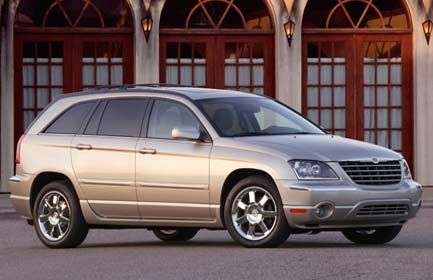While dissidents at the UAW whine that the Chrysler contract doesn’t guarantee them lifetime employment with penny one health coverage, something they apparently still delusionally believe to be the entitlement of anyone with a union card, Chrysler’s management is making it very plain why the company isn’t prepared to commit to four years of product plans: it’s still working on this month’s product plan.
According to the Detroit News, Chrysler management is expected to approve plans in the next two weeks to discontinue the production of five current models. The decision must be approved by Chrysler top brass and then by its owners, Cerberus. The move is seen as part of an overall plan to define brand identity more clearly by eliminating overlapping models and as a prelude to a possible overhaul of the dealer network, to the end of having all three Chrysler brands sold by all Chrysler dealers. It may also be viewed as an effort to begin upgrading the image of Chrysler products by eliminating those that can be sold only on price.
Specific models have not been identified. The likely nominees, according to some observers, are:
- Chrysler Pacifica – a dog in sales that has never come close to meeting expectations.
- Dodge Dakota – old model, with no real current market
- Jeep Commander – Only recently introduced, the seven passenger Jeep has been a sales disaster.
Dumping it now might set a record for the shortest time between introduction and termination of a new model.
Jeep Compass – the cheap $15,000 “Jeep” that can’t go off-road is considered to dilute the brand name and compete with Dodge offerings in the same price range with similar features and configuration. Recent reports have suggested that Chrysler’s new management wants Jeep to stick to it’s hard-core, off-road product line and image.
In particular, Chrysler has every reason to dump the Pacifica. Though it was the first vehicle in the market in which Buick has scored a home run with the Enclave, the Pacifica – overpriced, underpowered, unrefined, and unattractive – has been a dud from the start. With Chrysler’s new minivans on the same dealer lot, the chances of selling a Pacifica must be close to zero.
The Dodge Durango may also be at risk, with a 30% sales drop this year. The model is old and uncompetitive in a shrinking market. The New Jersey assembly plant that builds the Durango is to be closed in 2009. Dealers don’t want to stock the Durango and wouldn’t be sad to see it go. Chrysler’s redesigned Sebring has also been a bomb, but it may be too soon to drop it – it was introduced just last year.
Dodge dealers are unlikely to lament the demise of either the Dakota or the Durango, as they will be getting a new full-size pick-up truck for the upcoming model year.
The emphasis on eliminating overlapping models, of course, explains why Chrysler would not follow GM’s lead and commit in the UAW contract to building specific products at specific plants over the next four years. Not only is Chrysler looking to rapidly fill openings in its small car lineup by using a platform already developed by another car manufacturer from overseas, the company is clearly focused on streamlining its model line-up and concentrating on new products that are better positioned to sell.
The immediate emphasis on elimination of overlapping models, however, also suggests a change in dealer strategy. Chrysler reportedly wants to eliminate a number of dealers. Though the company recently abandoned a program designed to give large dealers priorities in ordering over smaller dealers, the company’s desire to reduce the total number of dealerships remains.
Eliminating overlapping models as soon as possible may be the prelude to combining all Chrysler made brands in a single dealership. The current dealer structure was created when Chrysler dealers normally also sold Plymouth. In that structure, the Dodge brand overlapped both Plymouth at the high end of its price range and Chrysler at the low end of that price range, but was primarily positioned between those two brands. Over the years, however, Dodge moved down-market, to the point that Plymouth was a surplus brand with only one stand-alone product, the Prowler. By that point, much of the Chrysler brand had also been moved down-market through emphasis on the mini-van line. Most recently, Chrysler dealers were given the Aspen, a version of the Durango.
Currently, Dodge has trucks, but otherwise the dealer offerings are similar, with Dodge’s clone of the 300, the Charger, differing in emphasis more than content. Elimination of overlapping models is the logical prelude to combining all three Chrysler brands into one retail outlet.
Though combining brands in one dealership would, at least initially, actually multiply the number of dealers carrying a given brand in a market, it would not really impact on the current dealer situation. The current product overlap effectively means that all Chrysler and Dodge dealerships pretty much carry the same line, anyway.
Like many of the decisions recently taken by Chrysler management, including hiring executives from other car companies, culling the losers from the product line is not a remarkable decision, not even an inventive one. But it is a decision that Chrysler’s past management failed to take. The real test for the new management, however, may come when it’s no longer enough to correct past mistakes.

